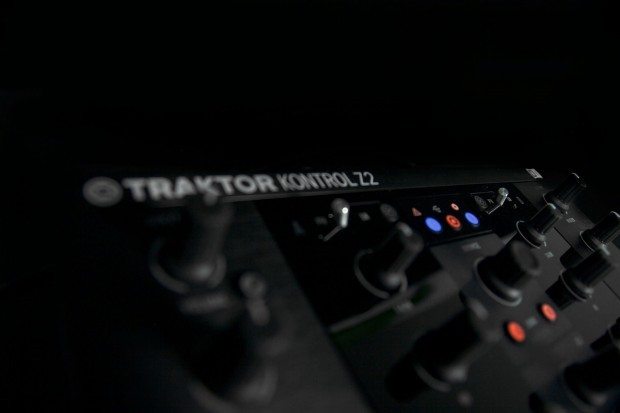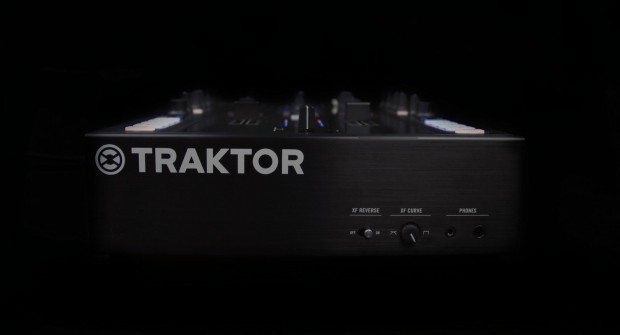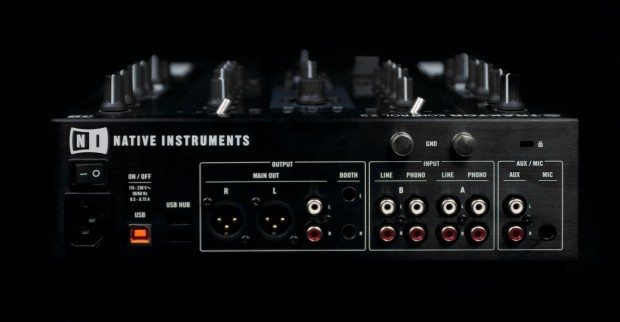Link: Native Instruments – Price: $799/€779/£629
Introduction
With smaller, ‘battle’ mixers getting thinner on the ground these days, the Kontrol Z2 was a little bit of a surprise release – especially at the price it’s at. It appears that essentially what Native Instruments have done is look at everything they’ve done in the past three or four years, throw it into a cauldron, stir it up with a little eye of newt and see if they could create the definitive hybrid mixer for the digital age. It’s a tall order, so I spent a fair bit of time figuring out where they’d succeeded.
Hardware
The first thing that struck me when I got the Kontrol Z2 out of the box was how well made it felt. Actually, no, that’s not quite it; the biggest success the Kontrol Z2 has straight out of the box is that it looks and feels like a professional DJ mixer. I’ve always been happy with the build quality of Native Instruments gear, but it and most other digital DJ equipment manufacturers have definitely created a new era of gear, and with it a new form factor. For those of us who’ve been around since vinyl, the compactness of the majority of digital DJ controllers is almost subliminally a bit of a turnoff. The Z2 is as big as any other two fader mixer (see NI, no ‘2 channel’ talk here!) and it’s constructed of a metal and plastic combination that’s reassuringly tough, and that tough feel carries through to every part of the mixer.
I’m going to go on record and say that whilst discrete metal pots might be preferable, I’m not concerned about the quality of the nylon shafted pots that NI are using. They feel great, presumably reduce cost, and I’ve never had any issues personally. I did uncover a somewhat embarrassing problem though: within what I would estimate at 20 hours scratching, I have worn the paint off from around the crossfader. Because I was so eager to get the Z2 between my decks, I didn’t take photos until after this had happened so you can see what I mean in the gallery. In a few more sessions the paint will be completely gone, which will make it look better than it does now, but still, it’s not ideal for a mixer less than a month old for the faceplate to already be disintegrating (okay, that’s an exaggeration).
Taking cues from recent NI hardware, the Kontrol Z2 features NI’s beautiful coloured button technology and two LED displays good for two characters each, lending svelte good looks and industrial style rugged demeanour respectively. Things are pretty much the same as they’ve been for a few years when it comes to the feel of Native Instruments hardware, so excuse me for not reinventing the wheel yet again when going into how things feel; perhaps look at my recent Kontrol F1 review for a more in depth description of the feel of the various knobs and buttons (although faders warrant a section below).
If there’s any really impressive innovation build wise it’s the magnetic faceplates first seen on Maschine MK2 a couple of months ago. Unless you’re told you would have have absolutely no idea that the faceplate lifts off the mixer in three parts (centre and each strip down the side) and when the inevitable replacement colours come out there’s going to be some totally unnecessary but nonetheless gorgeous customisation going on.
Ins and Outs
Inputs are by way of two switchable line/phono level RCA ins and a stereo RCA/mono jack aux input for line and dynamic mic/instrument level signals. The Kontrol Z2 acts as a hardware mixer for these channels, and when connected to Traktor can either switch to Traktor mode or optionally route the inputs directly to Traktor’s live input mode. The mic/aux channel has a nice ‘tone’ control in contrast to the more commonly seen high/low EQ which serves not only to cut down on physical controls clogging up the mixer surface, but also to speed up dialling in a crisp setting for voiceovers or instrument inputs.
An XLR master with secondary RCA output is joined by TRS jack booth outs, with booth and master having separate volume controls. There’s no send/return loop, and no foot pedal input, but there is a pair of USB2 inputs to allow the Kontrol Z2 to act as a hub for further controllers which is a really nice consideration and allows a single cable between your computer and the mixer to be all you need to hook up the mixer, Traktor Scratch, and two additional controllers.
The 48KHz audio interface is blazingly fast, and after speaking with many other scratch DJs there seems to be a general consensus – and as this is anecdotal please take it as such with the knowledge that we’re all prone to persuading ourselves things are true from time to time – that the Kontrol Z2’s method of controlling Traktor’s internal mixer actually makes scratching with DVS feel tighter as the small amount of latency added to the fader puts cutting more in sync with the software translated record movements.
Feel
Ergonomically, the Z2 is a tremendous success. Native Instruments should be really proud of what they’ve achieved when it comes to integrating the Z2’s brawn with the Traktor brain, because it looks like the Z2 should do a lot less than it actually does. It’s not the first DVS ‘hub’ mixer, of course, not even close – but to my grubby hands it feels the most streamlined and logical, and when comparing it to other mixers it seems somehow more elegant.
It’s important not to get swept away by the design aesthetic of the Z2, of course; there’s no point fawning over a mixer’s looks and allowing yourself (perhaps more aptly, myself) to get hypnotised without really looking at the nitty gritty. For instance, compared to the Pioneer DJM-T1 the Z2 is strikingly similar in many aspects. The basic layout is more or less the same, but on the T1 there’s a sense of things being squeezed in that just isn’t there with the Z2. To achieve the svelte feel of the Z2 Native Instruments have done a few things; the slimline tapering of the knobs creates the illusion of more space on the mixer, small but not cramped buttons for cue source and the like give an impression of spaciousness, and the tighter-than-tight integration with Traktor 2.6 has allowed NI to make better use of shift layers, colours, and their new built in macro effects to save on physical controls.
The much touted Mini-Innofaders have been discussed at length in all corners of the web, so I shan’t spend too much time on them. I love the crossfader – it’s probably one of my all time favourite contact based faders, in fact. I’m less keen on the upfaders as they’re set quite tight, and I can only imagine that there are more of you out there that prefer stiff upfader mixing than there are those of you that scratch on upfaders, swaying NI’s design decision. The promise of full Innofader compatibility for those that want to drop the extra cash for total customisation capability is certainly alluring, too.
With the Kontrol F1
Native Instruments have been slowly but surely wedging their foot into the DJ hardware door, and whilst the Z2 is more or less mismatched with most of the Kontrol line due to it either taking on a lot of its features onto its own back (the X1, at least in its factory mapped form) or appealing to a completely different use case (the S2 and S4), the F1 is an obvious bed partner. Keen to hammer home the point that the Z2 isn’t a just a two channel mixer, it’s a four channel controller in 12” format too, NI are finally showing us what they have in mind for the integration of the remix deck – and perhaps making it just a little bit clearer why they were so keen to make the F1 the only piece of gear that could take full advantage of them. The F1’s volume and filter controls makes the lack of faders on the mixer pretty much a non-issue, and the volume dial that comes instead is just fine for adjusting the levels of the layered channel. If I were to be picky I would perhaps say that a very short throw fader – even 20mm or less, akin to the short faders Vestax have used, for instance – would probably be preferable due to the speed at which they can be manipulated, but the rotary knob allows the volume to be precisely adjusted. In any case the combination of barebones controls on the Kontrol Z2 and specialised controls on the Kontrol F1 really works and faciliatates DJing with this new remix deck paradigm without any jumping through hoops or giving the feeling of the F1 being a tag along controller that sits awkwardly to the side of another controller.
The Kontrol Z2’s 1-4 buttons are by default switchable between loop recorder and sample retriggering controls, which indicates that NI have thought about how best to integrate the two, but you can of course make those four buttons do anything else Traktor can do.
In fact it’s the basic premise of the Kontrol Z2 that really makes it a marked about-turn from the way the market has seemingly been headed over the past few years. Suddenly it’s not about being an all in one any more, and it’s not even about mad scientist like modularisation and custom MIDI maps. It’s about being a brain that takes care of the heavy lifting while playback devices – be they turntables, CD decks, or pad controllers – sit either side and do their thing. Without doubt it’s the Traktor factor that makes this feel so fluid, because without it the Kontrol Z2 is a pretty simple mixer. With it, it’s such a breeze to actually DJ that it just seems… well, I don’t think I’m too far off the mark in expecting to see embedded computer brains in mixers such as these in the not too distant future.









